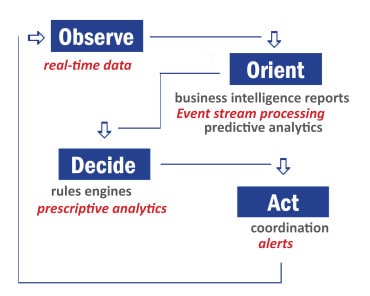
Predictive analytics use R-T data, AI to combat sepsis, help prevent 8,000 deaths.
Sepsis is an unforgiving condition that can wreak havoc on the body. It often creeps up, like a thief in the night, after people are already admitted to hospitals to treat other conditions. It erupts as the body is fighting infection, triggered by an imbalance in the very biochemicals the body is sending out into the bloodstream to fight infection. If sepsis progresses to septic shock, organs are damaged, and blood pressure drops – a potentially deadly situation. Sepsis is responsible for 270,000 deaths per year in the United States alone.
Typically, diagnosing sepsis is only possible based on manual review of patient charts during shift changes. The problem is by the time sepsis is detected this way, it may be too late. “Every hour of delayed diagnosis increases the risk of death by four to seven percent,” says Dr. Jonathan Perlin, president for clinical services and chief medical officer for healthcare at HCA Healthcare.
One of the nation’s leading providers of healthcare services, HCA is made up of locally managed facilities that include 185 hospitals and 119 freestanding surgery centers located in 21 U.S. states and in the United Kingdom. In May, HCA was named the 2019 Red Hat Innovator of the Year
Also see: How to Control Disease Outbreaks with Real-Time Tracking
This delay was not acceptable to practitioners at HCA Healthcare, and they decided to do something about it. A team of clinicians, data scientists, and technology professionals banded together to create a real-time predictive analytics system to more accurately and rapidly detect sepsis in patients.
Making Sense of Siloed Data, Quickly
The challenge was capturing the data related to pre-sepsis conditions. There was plenty of it generated by the healthcare company’s more than 30 million annual patient interactions each year across 1,800 care sites. However, much of it was siloed across disparate systems and applications.
“Our existing data infrastructure was designed for large-scale business intelligence and reporting, but this task is much different,” explains Dr. Edmund Jackson, chief data scientist at HCA Healthcare. “We need to gather, analyze, and share real-time data from all of our facilities so that life-saving action can be taken quickly.”
To address this challenge, the team created a real-time predictive analytics system called SPOT (Sepsis Prediction and Optimization of Therapy).
Built on Red Hat Foundation
SPOT is built on the Red Hat OpenShift Container Platform and Red Hat Ansible Tower, and automated cloud environment, providing an infrastructure to collect, analyze, and act on patient data. With SPOT, clinicians can more accurately and rapidly detect sepsis in patients. The platform collects and analyze clinical data — such as patient location, vital signs, pharmacy and laboratory data — and signals caregivers in real time to initiate early sepsis care.
“The ability to bring together petabytes of data and to be able to ask the questions that we need to ask to be able to bring answers to the bedside –that’s really the goal of being a learning health system,” says Perlin. “When the computer is monitoring those things, we can intervene in a way that saves lives we can train algorithms particularly with tools that Red Hat provides to be able to answer your questions the way that no one else can, and sometimes we capture that in new algorithms like our SPOT tool.”
With the SPOT tool and Red Hat infrastructure, HCA Healthcare’s clinicians are reporting the following benefits:
Improved early detection: By analyzing the volumes of patient data it collects and quickly alerting caregivers, SPOT has brought new best practices to minimizing sepsis. SPOT provides HCA Healthcare clinicians the ability to detect and identify initial indicators of sepsis up to 20 hours earlier than traditional screening methods. The SPOT system is now the core piece of the company’s “Surviving Sepsis” campaign, a global initiative to reduce sepsis mortality.
“SPOT is aware of every new piece of data, the relationships between data, and its meaning,” Perlin says. “Instead of reacting, we get a 20-hour early warning. When every hour counts in decreasing the risk of death, the ability to have an algorithm run in the background in real time, without downtime, to detect those signals is absolutely game-changing.”
Increased accuracy: HCA Healthcare is undergoing a cultural shift in which it quickly and confidently uses digital capabilities and establish best practices for patient care – even across hundreds of systems and applications at each facility, from fetal monitoring to accounting to supply chain management.
“About 80% of a patient chart is not computable,” according to Perlin. However, with new tools such as natural language processing and machine learning, the system is taking advantage of new insights from that unstructured data. “As the pilot project, SPOT has been an important tool for building clinicians’ trust in the computer to see associations that they cannot see and act on those predictions. As a return for the time spent on creating patient EHRs, we create value for them from that data.”
Enhanced learning: HCA Healthcare’s goal is to unite its care and business professionals to form a learning healthcare system, a collaborative, transparent model approach that uses data from each interaction as a source for continuous learning and improvement. “When the computer is monitoring those things we can intervene in a way that saves lives,” Perlin says. “We can train algorithms to be able to answer your questions the way that no one else can.”
The SPOT platform has now been deployed to more than 160 hospitals to monitor more than 2.5 million patients to date. Perlin says the benefits speak for themselves. “When we look at our Surviving Sepsis campaign and the implementation of SPOT, we’ve saved nearly 8,000 lives,” he says.
SPOTing Other Threats
SPOT is the first of many initiatives across the organization to use real-time data at scale to improve patient care with new insights
HCA Healthcare is also employing its open source, Red Hat-based foundation to develop new algorithms for other conditions and care settings.
HCA Healthcare’s clinical and data science teams expect to continue to improve the algorithm, combining real-world experiences and outcomes with techniques of machine learning and artificial intelligence to enhance clinical effectiveness. Building upon the SPOT technology employed in the inpatient setting, HCA Healthcare is developing “SPOT-ER,” which HCA plans to begin deploying in emergency rooms this year.
HCA Healthcare also has plans to use machine learning to more quickly detect other critical or life-threatening conditions such as shock in trauma patients, post-operative complications, and early signs of deterioration in all patients. The opportunity to improve care through clinical informatics and machine learning is substantial, and HCA Healthcare is leveraging its scale to do so.
Learn more about SPOT





























